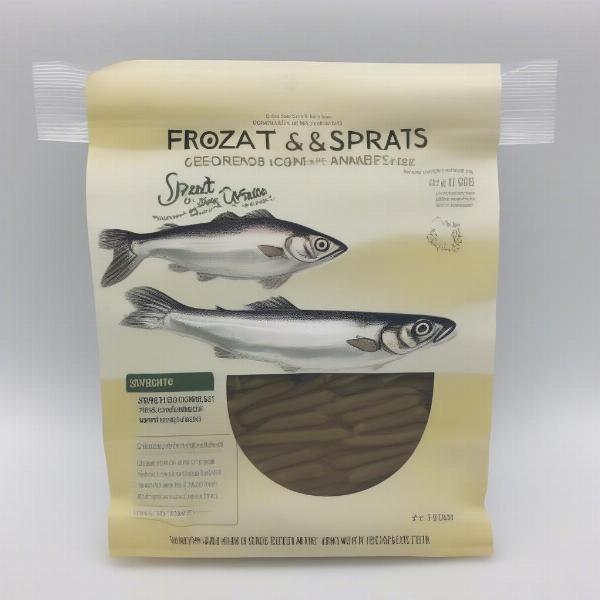Frozen sprats are becoming an increasingly popular food choice for dogs, touted for their nutritional benefits and palatability. But are they a suitable addition to your dog’s diet? This article will delve into the pros and cons of feeding your canine companion frozen sprats, covering everything from nutritional value to safe handling practices.
Understanding the Nutritional Benefits of Frozen Sprats
Frozen sprats are small, oily fish packed with essential nutrients that can benefit your dog’s health. They are a rich source of omega-3 fatty acids, particularly EPA and DHA, known for their anti-inflammatory properties. These fatty acids contribute to healthy skin and coat, joint health, and cognitive function. Sprats also provide a good dose of protein, vital for muscle development and repair. Additionally, they contain essential vitamins and minerals like vitamin D, vitamin B12, and selenium, which support overall health and well-being.
Are frozen sprats better than other fish options? While many fish offer similar benefits, sprats are often smaller and easier for dogs to consume, especially smaller breeds. Their smaller size also means they accumulate fewer toxins like mercury compared to larger fish.
Safely Incorporating Frozen Sprats into Your Dog’s Diet
Before introducing frozen sprats to your dog’s diet, it’s essential to consult with your veterinarian. They can advise on the appropriate portion size based on your dog’s breed, age, activity level, and overall health. Too many sprats can lead to an imbalance in nutrients or digestive issues like diarrhea.
How should you prepare frozen sprats for your dog? Always thaw the sprats thoroughly before serving. Avoid cooking them, as high heat can destroy valuable nutrients. Simply let them defrost in the refrigerator or under cold running water. Never microwave them, as this can create hot spots that could burn your dog’s mouth.
Potential Risks and Considerations of Frozen Sprats for Dogs
While generally safe, frozen sprats can pose some risks if not handled or fed correctly. Some sprats are packaged with added salt, which can be harmful to dogs in large quantities. Choose unsalted varieties whenever possible. Small bones in sprats can also be a choking hazard, especially for puppies or small breeds. Consider mashing them or chopping them into smaller pieces before serving. Finally, some dogs may be allergic to fish. Introduce sprats gradually and monitor your dog for any signs of an allergic reaction, such as itching, vomiting, or diarrhea.
“When introducing any new food, start with a small amount and observe your dog for any adverse reactions,” advises Dr. Emily Carter, DVM, a veterinary nutritionist. “If you notice any unusual symptoms, discontinue feeding and contact your veterinarian.”
Are Frozen Sprats Right for Your Dog?
Frozen sprats can be a healthy and enjoyable addition to your dog’s diet when fed responsibly. They provide a rich source of omega-3 fatty acids, protein, vitamins, and minerals. However, it’s crucial to consult your veterinarian, choose unsalted varieties, prepare them safely, and monitor your dog for any potential issues.
 Frozen Sprats Packaging
Frozen Sprats Packaging
Conclusion
Frozen sprats offer several potential health benefits for dogs due to their rich nutritional profile. However, responsible feeding practices are crucial to ensure your dog enjoys these benefits safely. Always prioritize your veterinarian’s guidance and monitor your dog’s response to this new food. By following these guidelines, you can make informed decisions about incorporating frozen sprats into your dog’s diet.
FAQ
- Can I give my puppy frozen sprats? While sprats are nutritious, their small bones can be a choking hazard for puppies. Consult your vet before introducing them and consider mashing them first.
- How often can I feed my dog frozen sprats? The frequency and portion size will depend on your dog’s individual needs. Your veterinarian can provide specific recommendations.
- What are the signs of a fish allergy in dogs? Common signs include itching, redness, skin rashes, vomiting, and diarrhea.
- Can I cook frozen sprats for my dog? While cooking is not necessary, if you do choose to cook them, avoid high heat as it can destroy essential nutrients.
- Where can I buy frozen sprats for my dog? Frozen sprats intended for pets can be found at many pet stores and online retailers.
- Are dried sprats as healthy as frozen sprats? Dried sprats can be higher in sodium, so opt for frozen or fresh whenever possible.
- What should I do if my dog has an adverse reaction to frozen sprats? Discontinue feeding immediately and contact your veterinarian.
About ILM Dog
ILM Dog (https://ilmdog.com) is your trusted international resource for all things dog-related. We offer expert advice on Dog Breeds and Selection, Health and Medical Care, Training and Behavior, Nutrition and Feeding, Grooming, and Products and Accessories. Our mission is to empower dog owners worldwide with the knowledge and resources they need to provide the best possible care for their canine companions. Need advice tailored to your dog’s unique needs? Contact us at [email protected] or call us at +44 20-3965-8624.